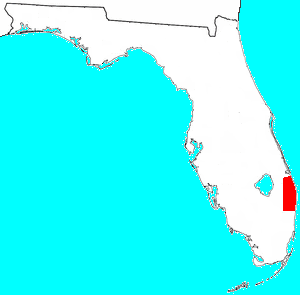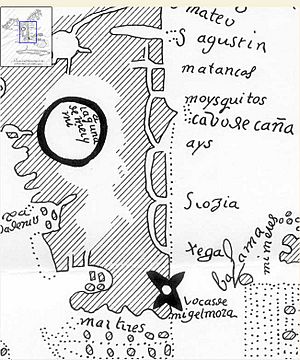Jaega facts for kids
The Jaega (also Jega, Xega, Jaece, Geiga) were a group of Native American people who lived in Florida, near the coast in what is now Martin and northern Palm Beach Counties, when Europeans first arrived hundreds of years ago. They lived in a society led by a chief and were known for their connection to the land and sea.
Contents
People of the Florida Coast
Imagine a time long ago, before cars, cities, and even before the United States existed. In what is now the southeastern part of Florida, along the beautiful Atlantic coast, lived various groups of Native American people. One of these groups was known as the Jaega.
The Jaega were a distinct group, but they were also connected to other Native American peoples living nearby, like the Ais to the north and possibly the Tequesta to the south. They lived in a specific area that stretched along the coast.
The name "Jaega" could be spelled in different ways, like Jega, Xega, or Geiga. Sometimes, a name like Jobé or Jové was used, which might have been another name for the Jaega, a smaller group within the Jaega, or even the name of one of their main towns. These different names can sometimes make studying history a bit like solving a puzzle!
Where Did the Jaega Live?
The homeland of the Jaega was located in a coastal area that is now part of Martin County and the northern part of Palm Beach County in Florida. This region included important places like the St. Lucie Inlet and the Jupiter Inlet.
Archaeologists, who are like history detectives who study old things found in the ground, call this area the East Okeechobee culture region. This region was special because it was a place where different ways of life met. To the north were people influenced by the St. Johns and Indian River cultures, and to the west and south were cultures like the Belle Glade and Glades cultures. The Jaega's area seemed to blend influences from these neighbors, especially from the north after the year 1000 AD.
The Jaega lived along the coast and likely used the rivers, inlets, and the ocean for travel and resources. Their territory was a beautiful place with beaches, coastal forests, and wetlands.
What Was Their Culture Like?
Because the Jaega did not write down their own history, most of what we know about their culture comes from what archaeologists have found and what early European visitors wrote down. These written accounts are few, so there is still much to learn!
Based on what we know, the Jaega were likely very similar in their way of life to their neighbors, such as the Calusa, Tequesta, and Ais. These groups were primarily hunter-gatherers. This means they didn't farm crops like corn or beans as some other Native American groups did. Instead, they found all the food they needed from nature.
The area where the Jaega lived was rich in natural resources, providing plenty of food. Their diet included:
- Fish, shellfish (like oysters and conch), and sea turtles.
- Animals like deer and raccoons.
- Wild fruits and roots such as cocoplums, sea grapes, palmetto berries, and tubers.
Archaeologists find clues about their diet and daily life in places called middens. Middens are like ancient trash piles, often made up of discarded shells from the shellfish they ate, along with broken tools, pottery pieces, and other items. One famous Jaega midden is located at DuBois Park near the Jupiter Inlet, right across from the Jupiter Inlet Lighthouse. It's a historical treasure!
Besides finding food, the Jaega were skilled craftspeople. They made tools and weapons from materials they found around them:
- Shells: Used to make tools.
- Bone: Used to make tools and ornaments (like jewelry).
- Wood: Used for various purposes, though wooden items don't survive as well over time.
Interestingly, even though there isn't much flint (a type of stone used for sharp tools like arrowheads) in South Florida, archaeologists have found flint dart points at Jaega sites. This suggests that the Jaega traded with groups living further north who had access to flint.
They also made pottery, using clay to create pots and other containers. Bits of broken pots are often found at their living sites. The text also mentions scraps of grass skirts, suggesting they knew how to weave or make clothing from plant materials.
Early European visitors also wrote about the Jaega having complex social structures and ceremonies. They described elaborate rituals that involved many people, including priests, hundreds of singers, and dancers. This suggests they had organized religious or social practices and perhaps different levels of importance among their people, with an "elite class" possibly involved in these ceremonies.
How Did They Interact with Others?
The Jaega interacted with both neighboring Native American groups and, later, with Europeans, particularly the Spanish.
Interactions with Other Tribes
The Jaega were connected to the Ais people to their north. Some accounts suggest they spoke a similar language. There were also ties through marriage between the leaders (chiefs) and their families from the Jaega and Ais groups. This shows they had alliances and relationships with their neighbors. The text mentions that the town of Jobé was subject to the Ais chief who lived further north, indicating a political connection or hierarchy between the groups.
Interactions with Europeans (Spanish)
The first known mention of the Jaega comes from a Spanish person named Hernando de Escalante Fontaneda. He was shipwrecked and lived among Native Americans in Florida for 17 years until around 1565 or 1566. He wrote that the Jaega, along with the Ais and another group called the Guacata, were known for finding valuable items like precious metals from ships that wrecked along the coast. Shipwrecks were quite common in this area due to the strong currents and reefs.
The Spanish tried to establish a presence in the area. In 1565, they built a fort called Santa Lucia, first in Ais territory and later, after being driven out, they built a new fort with the same name near the Jupiter Inlet, which was in Jaega territory.
Initially, the Jaega were described as friendly towards the Spanish at the Jupiter Inlet fort. However, this friendliness didn't last. The Jaega later attacked the fort, and the Spanish were forced to leave in less than a year. This shows that the Jaega were willing to defend their territory and independence.
Over time, the relationship changed. By the 1620s, the Jaega had entered into friendly relations with the Spanish. This might have involved trade or other forms of interaction.
Spanish maps and reports from the 17th century often included the names Jaega and Jobé, showing that the Spanish were aware of these people and their location.
Another important account comes from Jonathan Dickinson, who was shipwrecked in the area in 1696. He and his group were held in the town of Jobé for several days. His journal provides valuable descriptions of the people and their customs at that time. He noted that Jobé was under the authority of the Ais chief.
Later, in 1738, the Spanish governor of Florida, Manuel de Montiano, mentioned the Jaega in a letter. He wrote about a battle in central Florida involving several Native American groups and mentioned that a scout met with a chief from another group at a town called Jaega. This suggests the name or people were still present or remembered in the area at that time.
What Happened to the Jaega?
Like many Native American groups in Florida and across the Americas, the Jaega faced immense challenges after the arrival of Europeans. These challenges included:
- Disease: Europeans unknowingly brought diseases like smallpox, measles, and influenza, to which Native Americans had no immunity. These diseases could spread rapidly and cause devastating population declines.
- Conflict: Interactions with Europeans and other Native American groups sometimes led to conflict and warfare.
- Displacement: As European colonies grew, Native American groups were often forced off their traditional lands.
- Cultural Disruption: Changes in trade, alliances, and ways of life disrupted traditional cultures.
It is likely that the Jaega population declined significantly due to these factors during the 17th and 18th centuries. Survivors may have joined other Native American groups or been absorbed into the changing colonial society. By the time Florida became part of the United States, the original coastal groups like the Jaega were no longer present as distinct communities.
Archaeology
Archaeology is crucial for understanding the Jaega because written records are so limited. By carefully excavating and studying sites where the Jaega lived, archaeologists can learn about:
- Their Diet: By studying animal bones, shells, and plant remains found in middens.
- Their Tools and Technology: By finding and analyzing artifacts made of stone, bone, shell, and pottery.
- Their Settlements: By mapping the locations of homes, mounds, and other structures.
- Their Interactions: By finding items that came from other areas, suggesting trade or travel.
- Their Beliefs and Practices: By studying burial sites or ceremonial objects, although the text doesn't detail these for the Jaega specifically.
Archaeological work in the East Okeechobee region helps us piece together the daily lives, customs, and history of the Jaega people. Sites like the one at Jupiter Inlet are important windows into the past.
Names That Remain Today
Even though the Jaega people are no longer present as a distinct group, their name lives on in the places where they once lived.
The geographic name "Hobe Sound" is a direct link to the Jaega. It comes from the name of the Jaega village of Jobé, where Jonathan Dickinson was held in 1696. The Spanish pronounced Jobé more like "Ho-bay," and over time, this evolved into the English name "Hobe," which is pronounced like the word "robe."
The name "Jupiter Inlet" might also be connected. The Spanish sometimes spelled Jobé as Jové. It's thought that the name "Jupiter" might have come from an English attempt to pronounce "Jové," perhaps confusing it with the Roman god Jupiter.
These place names serve as reminders of the people who lived on this land for centuries before European settlement.
Conclusion
The Jaega were an interesting and important group of Native Americans who thrived along the coast of Florida for hundreds of years. They were skilled hunter-gatherers, connected to their environment and neighboring tribes. While much of their history is known through archaeology and brief European accounts, their story is a vital part of the rich history of Florida and its original inhabitants. Studying groups like the Jaega helps us understand the diverse cultures that existed in North America long ago and the impact of historical events like European contact.



